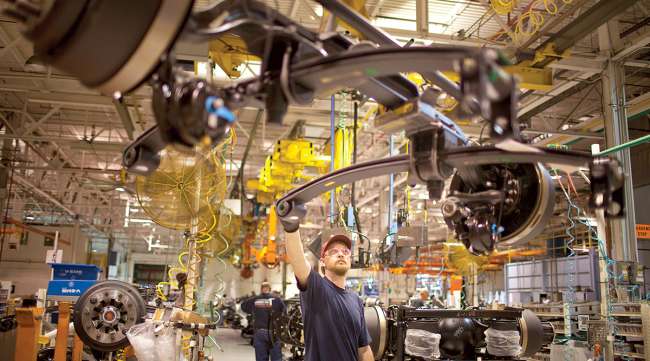November Class 8 Orders Show First Decline of 2018 as Production Roars On

Class 8 orders in November dropped to 27,900, marking the first year-over-year decline in 2018 as well as the lowest total this year, ACT Research Co. reported.
Orders fell 15% compared with 32,637 a year earlier, and marked the first decline in 14 months, according to ACT’s preliminary results. Truck makers’ final updates will be available later this month.
Industry analysts said they were expecting the falloff as Class 8 backlogs — fueled by a waves of large orders over the past 13 months — remain elevated, leaving few available production slots for 2019.
“Quite honestly, at 300,000-plus, the backlog is largely spoken for through the end of 2019,” ACT Vice President Steve Tam told Transport Topics.
Tam said he has heard from many manufacturers that indicated their most popular models are sold out through the end of the year and don’t have any capacity to produce more due to “minor snags” in parts availability involving Tier 2 suppliers.
“But Tier 2 can impact Tier 1, of course,” he said.
Meanwhile, cancellations (which are announced in the middle of each month and after the preliminary net orders) in October were the highest since ACT began keeping records in 1986. They hit 10,900.
“It’s almost as if — and I don’t want to dismiss it — it is business as usual,” he said.
The seasonal factor for cancellations in any October is 50% — meaning October cancellations are 50% higher than the average month’s cancellations because of truck makers’ housekeeping and scrubbing of place-holder orders that are not going to get built and shifting around of others as the year draws to a close.
“So if you seasonally adjust that almost 10,900 you get 5,000 or 5,500 and that brings us back in to the realm of where we have been up until this point,” Tam said. “There is just no crisis or concern among the truck-buying population. Truckers were not canceling orders because the sky is falling.”
Quite honestly, at 300,000-plus, the backlog is largely spoken for through the end of 2019.
Steve Tam of ACT
When you have a backlog in excess of 300,000 units, having elevated cancellations is just “part and parcel” of the environment the industry is in, he said.
“That’s why we measure cancellations as a percentage of the backlog. They were above target on a nominal basis, but if you seasonally adjust them, they were not.”
ACT is forecasting North American Class 8 production in 2019 of 335,000 units, with a little bit of upside depending on the performance of the supply chain feeding production.
The research firm FTR pegged orders at 27,500.
“If it wasn’t November [typically one of the top order months], that would still be a very good number,” and a little higher than straight replacement demand, said Don Ake, vice president of commercial vehicles at FTR.
He agreed that there is just not the production capacity left. “Orders will probably be below 20,000 in December.”
Order cancellations will spike again in the second half of 2019, Ake suggested, as the fleets look at how many trucks they really need of the orders they placed earlier.
But if that happened production could still be at extremely high levels, he said.
“Imagine what happens to the backlog. You could backlog dropping by 20,000 a month, but if it’s still elevated, is the market collapsing? No,” he said.
Ake said the wild card is, what is the economy going to be like in 2020? “Our forecast is for slower growth.”
In the meantime, Volvo Trucks North America announced it is making available Payload Plus packages on orders of its Volvo VNR and VNL series. They are aimed at tanker and bulk haulers and intended to help simplify the spec’ing process.
Key lightweight components in the Payload Plus packages include horizontal exhaust, aluminum wheels, lightweight chassis components. Additional opportunities to reduce weight based on application can include optimized wheelbases and frame rail thicknesses, according to VTNA, a unit of Volvo Group.
“The respective packages reduce the weight of Volvo VNR regional models by up to 540 pounds and by more than 335 pounds from Volvo VNL long-haul models.
In related news, tractors represented 73% of total Class 8 production in 2018, but are forecast to fall to 68% by 2021, with straight trucks expected to grow to 32%, according to Tom Rhein, president of Rhein Associates.
“Simultaneously, the trend to smaller displacement engines in Class 8 will continue through the forecast period, with 12-14L engines exceeding the 14L category for the first time in 2019,” he said.
The key metrics that measure the health of the trucking industry are freight rates and order cancellations, Tam said. “Don’t blink and don’t go to sleep.”



